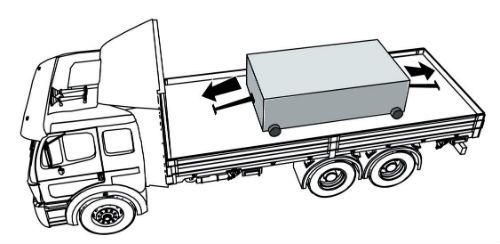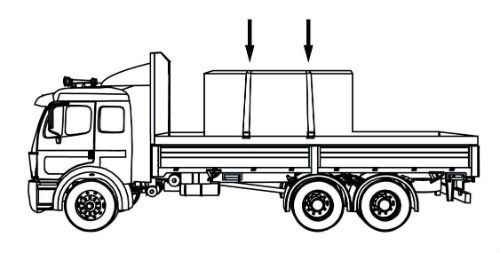CDL Practice Tests: Flatbed Cargo Securement
Choose A Section:
Go!Who is responsible for inspecting securing devices and cargo within the first 50 miles?
- The D.O.T.
- Your Moms.
- The shipper.
- The driver.
Inspect Cargo and Securing devices:
- Pre-Trip: Yes
- Within first 50 mi: Yes
- When duty status of driver changes: Yes
- At 3 hour intervals or every 150 mi, whichever is first: Yes
When loading paper rolls with eyes horizontal, which of the following is not a requirement for stacking a second layer:
- Place second layer with eyes vertical.
- It must be blocked against an eye-vertical blocking roll resting on the floor of the vehicle that is at least 1.5 times taller than the diameter of the roll being blocked.
- All the wells in the layer beneath must be filled
- The bottom layer must extend all the way to the front.
Requirements for eyes crosswise: secure stacks of paper rolls from front-to-back movement
- Do not load paper rolls on a second layer unless the bottom layer extends to the front of the vehicle.
- Load paper rolls on higher layers only if all wells in the layer beneath are filled.
-
Secure the foremost roll in each upper layer (or any roll with an empty well in front of it) against forward movement:
- Either by placing it in a well formed by two rolls on the lower row whose diameter is equal to or greater than that of the roll on the upper row.
- Or by banding it to other rolls.
- Or by blocking it against an eye-vertical blocking roll resting on the floor of the vehicle that is at least 1.5 times taller than the diameter of the roll being blocked.
When a tiedown is attached directly to the cargo, what is the ideal angle where it attached to the vehicle?
- Less than 45 degrees.
- 90 degrees.
- Between 45 and 60 degrees.
- It doesn't matter.
The angle where the tiedown attaches to the vehicle should be shallow, not deep (ideally less than 45).
When securing building materials, how many knots are acceptable in the tiedown(s)?
- Depends on the weight of the cargo.
- 1
- 2
- 0
Requirements for Securement System:
- In proper working order with no damaged or weakened components that affect their performance or reduce their working load limit.
- No knots.
- Attached and secured in a manner that prevents them from coming loose during transit.
- Able to be tightened by a driver of an in-transit vehicle.
- Located inboard of rub rails whenever practicable.
- Edge protection must be used when a tiedown would be subject to abrasion or cutting.
Working Load Limit (WLL)is defined as:
- The maximum load that may be applied to a component of a cargo securement system during normal service, usually assigned by the manufacturer of the component.
- The acceleration due to gravity, 9.823 m/sec2 (32.2 ft/sec2).
- The number of hours that a tiedown can be used.
- The summation of the working load limits or restraining capacity of all devices used to secure an article on a vehicle.
Working Load Limit (WLL):
The maximum load that may be applied to a component of a cargo securement system during normal service, usually assigned by the manufacturer of the component.
While driving, the freight must not:
- All of these things should be avoided.
- Prevent the exit of a person from the cab.
- Obscure the driver's view ahead, left, or right.
- Interfere with the free movement of the driver's arms or legs.
- Obscure the driver's view ahead or to the right or left sides (except for drivers of self-steer dollies).
- Interfere with the free movement of the driver's arms or legs.
- Prevent the driver's free and ready access to accessories required for emergencies. OR
- Prevent the free and ready exit of any person from the commercial motor vehicle's cab or driver's compartment.
When securing concrete bell pipe in multiple complete tiers, all of the following are true except:
- Bells of the upper tiers must all be on the opposite side of the vehicle from the bells of the tier below.
- Stack the tiers in pyramid fashion.
- All of these apply.
- Bells of the bottom tier must all be on the same side of the vehicle
More than one tier with complete tiers

Bells of the bottom tier must all be on the same side of the vehicle
Bells of the upper tiers must be are on the opposite side of the vehicle from the bells of the tier below.
When securing rows of coils, requirements include all of the following except:
- Attach at least one tiedown over the top of each coil or side-by-side row, located near the front of the coil.
- Attach at least one tiedown over the top of each coil or side-by-side row, located near the rear of the coil.
- Use blocking or friction mats to prevent forward movement.
- Attach at least one tiedown through the center of each row of coils.
Tiedowns

Attach at least one tiedown over the top of each coil or side-by-side row, located near the front of the coil.
Attach at least one tiedown over the top of each coil or side-by-side row, located near the rear of the coil.
Use blocking or friction mats to prevent forward movement.
What is the minimum securement requirement for paper rolls with eyes vertical with a width between 1.25 and 1.76 its diameter?
- Tiedowns.
- Friction mats alone.
- All of these are required.
- Banding them together.
Situation #4
- A paper roll or the forwardmost roll(s) in a group of paper rolls is not prevented from tipping or falling forward by vehicle structure or other cargo.
- Paper roll width is more than 1.25 times and less than 1.76 times its diameter.
- Only friction mats are used for forward securement.
Solution #4:
The friction mat alone is adequate. The friction mat allows the roll to slide on the floor without tripping the roll.
About The Flatbed Cargo Securement CDL Manual
Studying the flatbed cargo securement CDL manual is not a requirement for getting your CDL permit or license. It is required knowledge for flatbed drivers.
Some questions you should be able to answer for flatbed cargo securement:
- What is the minimum Working Load Limit of a tiedown used to secure logs?
- What is the minimum weight of a shipment of paper rolls that would require specific securement requirements?
- When securing concrete pipe over 45 inches loaded crosswise, which direction must the tiedowns on the front half of the load run?
- What is a cab shield?
- When securing concrete pipe over 45 inches loaded crosswise, which direction must the tiedowns on the rear half of the load run?
- What is a dunnage bag?
- Who is responsible for inspecting securing devices and cargo within the first 50 miles?
- How many tiedowns are required on a stack of shortwood loaded crosswise?
- What is the minimum working load limit of each tiedown used to secure crushed or flattened vehicles?
- Define 'bolster'
- What is a hook-lift container?
- When a tiedown is attached directly to the cargo, what is the ideal angle where it attached to the vehicle?
What is a securing device?
Any device specifically manufactured to attach or secure cargo to a vehicle or trailer:
- Synthetic Webbing
- Chain
- Wire rope
- Manila rope
- Synthetic rope
- Steel strapping
- Clamps and latches
- Blocking
- Front-end structure
- Grab hooks
- Binders
- Shackles
- Winches
- Stake pockets
- D-rings
- Webbing ratchet
- Bracing
- Friction mat
What is a tiedown?
A combination of securing devices that forms an assembly that:
- Attaches cargo to, or restrains cargo on a vehicle.
- Is attached to anchor point(s).

Some tiedowns are attached to the cargo and provide direct resistance to restrain the cargo from movement.

Some tie-downs pass over or through the cargo. They create a downward force that increases the effect of friction between the cargo and the deck. This friction restrains the cargo.
 Related Cargo Securement Terms That Every Driver Should Know:
Related Cargo Securement Terms That Every Driver Should Know:
-
Tiedown:
A combination of securing devices which form an assembly that attaches cargo to, or restrains cargo on, a vehicle or trailer, and is attached to anchor point(s).
-
Contained:
Cargo is contained if it fills a sided vehicle, and every article is in contact with or sufficiently close to a wall or other articles so that it cannot shift or tip if those other articles are also unable to shift or tip.
-
Blocking:
A structure, device, or another substantial article placed against or around an article to prevent horizontal movement of the article.
How should tiedowns be attached?
Tiedowns can be used in two ways:
-
Attached to the cargo:
- Tiedowns attached to the vehicle and attached to the cargo.
- Tiedowns attached to the vehicle, pass through or aroundan article of cargo, and then are attached to the vehicle again.
-
Pass over the cargo:
- Tiedowns attached to the vehicle, passed over the cargo, and then attached to the vehicle again.
Tiedown placement:

Place the tiedown as close as possible to the spacer.
Position the tiedowns as symetrically as possible over the length of the article.

Position the tiedowns to preserve the integrity of the article.







 TT On Facebook
TT On Facebook